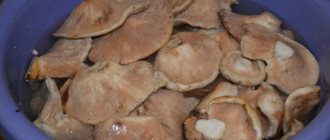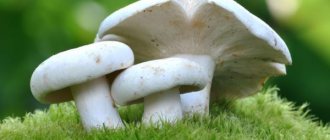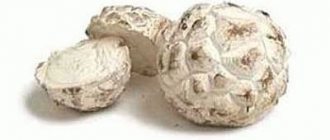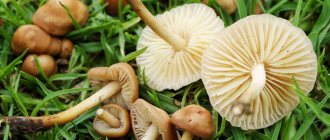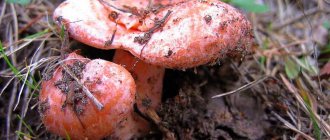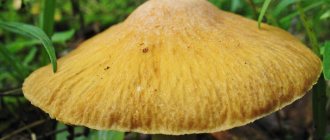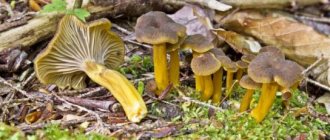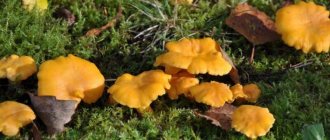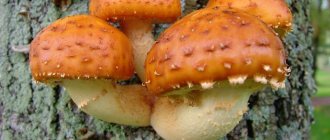Description
Morels belong to the Morchella genus of mushrooms. The most common of them is the conical morel (Morchella conica), other species are rare. The structure of the morel cap is symmetrically cellular. These are edible mushrooms.
— Advertising —
Spring conditionally edible mushrooms belong to the genus Gyromitra. Known species are the common stitch (Gyromitra esculenta) and the giant stitch (Gyromitra gigas). They differ from morels by the asymmetrical brain-like structure of the cap.
hat
The shape of the cap of mushrooms is different: for strings it is irregularly rounded, and for morels it is ovoid.
Pulp
— Advertising —
Morels are hollow inside, both in the cap and in the stem. The cells are visible only on the surface of the fruiting body of the mushroom. The lines inside are filled with twisted pulp.
Leg
The cap and stem of the morel are almost the same in length. Only the morel cap has an elongated stem with a bell-shaped cap. The stems of the stitches are shortened, sometimes completely invisible.
to “Autumn Line”
Thank you for the article! Repeatedly, starting from the 20th of September, I encountered autumn lines in the forest (North Moscow Region). By the way, there are quite a few of them growing, especially on rubble. But God bless him, with the autumn line, this fall, until the end of November, there was an ocean of purple, but no one took it, they said it was toadstools.
I don’t argue - perhaps the line is autumn and is growing en masse. But I haven't met yet
The autumn stitch does not look very attractive. Yes, in general, we only collect well-known mushrooms.
Tatyana, in the first photo he is so “unlikable”. Because it's old. I just wanted to show the mushroom “in profile”, but I couldn’t find a better photo. And the autumn line looks good. But the taste is nothing special
I haven’t seen any autumn lines, it seems. They look, one might say, photogenic. I also somehow did not use spring ones due to conflicting information about them.
Read also: Milkweed: medicinal plant, application, reviews, beneficial properties, contraindications
Autumn stitch is a species that is quite widespread in Eurasia. It is logical to assume that this mushroom grows in the Urals. Most likely they weren't paying attention.
I used to collect lines, but now I rarely come across them. Alexander, Happy New Year! I wish you and your family health, success in blogging, and good mood all year long!
Thank you, Nadezhda Semyonovna!
I was in Voronezh as a child, and there these lines, morels are considered quite edible mushrooms. I regret that I never tried it more than once - I disdained it. In appearance, the stitch looks like a rotten mushroom, especially in the first photo.
Alexander, I still think those lines and morels are taken in the spring. This same line is autumn. It is generally considered poisonous. But some authors who, in my opinion, deserve trust (I’m writing about this) talk about its edibility. And that the mushroom was declared poisonous by mistake. I tried it and didn’t get poisoned. Although I’m unlikely to take it - the taste is very mediocre. The mushroom in the first photo is old and overgrown. I just wanted to show the shape of the cap - but I couldn’t find a better photo with a more attractive mushroom - it didn’t work out
Yes, such mushrooms in the fall are probably taken by the most experienced mushroom pickers, and then only if they don’t find anything. Russulas, rows, it’s better to take these mushrooms into the basket.
Alevtina Mikhailovna, perhaps, is not worth taking lines in Crimea. Still, the climate is warmer than ours in the middle zone. What if there really is more gyromitrin in them than in our lines?
Alexander, Happy New Year! All the very best in the new year! Happiness, good luck, health!
And to you, Tatyana, and to you - Happy New Year!
Not the most attractive looking mushroom, even if you don’t pay attention to the first photo. I probably wouldn't risk trying. If some experts doubt its edibility, apparently, not everything is so simple. And it’s common for an inexperienced mushroom picker to make a mistake in classification)
Not everything is clear with conditionally edible mushrooms. Is it worth bothering with removing toxins and bitterness from such mushrooms if there are edible mushrooms?
Konstantin, I tried the autumn line once and, most likely, I won’t take it again - it’s not worth it. Another thing is related mushrooms from the same genus and family: common string, giant string, discina thyroid. These mushrooms appear in the spring, when the snow has not yet melted everywhere. Therefore, although they also need to be boiled first, this activity makes sense. We eat spring lines, no one got poisoned. I’d better keep silent about experts from the Internet. Mikhail Vishnevsky is an expert for me. And one of the authors of the second book I mentioned is F.B. Hannibal is also a mycologist, but not from Moscow, but from St. Petersburg. About conditionally edible mushrooms... These are all milk mushrooms, podgruzdki, volnushki (and in general, almost all milk mushrooms are bitter!), Most of the rows are conditionally edible. Autumn honey fungus is a magnificent mushroom, but it is recommended to boil it first! If you don’t take the listed mushrooms... What are we going to salt?

